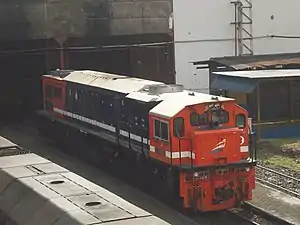EMD GT38ACe
The EMD GT38ACe (known as CC205 in Indonesia) diesel-electric locomotives are made by Electro-Motive Diesel for export in Indonesia. There are 55 locomotives owned by the state-owned Indonesian Railway Company (PT Kereta Api Indonesia), all of them are for in Sumatra and replace the aging EMD G26. It's also one of two most advanced-technology locomotive in Indonesia (another one is GE CM20EMP).
| EMD GT38ACe | |||||||||||||||||||||||||||||||||||||||||||||
|---|---|---|---|---|---|---|---|---|---|---|---|---|---|---|---|---|---|---|---|---|---|---|---|---|---|---|---|---|---|---|---|---|---|---|---|---|---|---|---|---|---|---|---|---|---|
 EMD GT38ACe. | |||||||||||||||||||||||||||||||||||||||||||||
| |||||||||||||||||||||||||||||||||||||||||||||
| |||||||||||||||||||||||||||||||||||||||||||||
| |||||||||||||||||||||||||||||||||||||||||||||
| |||||||||||||||||||||||||||||||||||||||||||||
History
PT Kereta Api Indonesia has operated some EMD G26 (G26MC-2U, or known in Indonesia as CC 202) since 1986 and some of them began to break down due to their ages and severe works. In 2011, PT Kereta Api Indonesia began to look for the replacements of G26MC-2U; more powerful and advanced locomotives than G26MC-2Us. After several auction processes, EMD won the contract to build more powerful locomotives with AC traction technology for PT. KAI.
Numbering
The Locomotives were numbered as CC 205 01 to CC 205 55 (including the bonus unit). But, due to the most recent regulation of the Ministry of Transportation, then the numbering system is changed according to its arrival year.
- The First Arrival (2011)
In this year, the first six locomotives arrived. Their numberings were CC 205 01 to CC 205 06. However, to comply with the most recent regulation, the numberings were changed into CC 205 11 01 to CC 205 11 06
- The Second Arrival (2013)
There were 44 locomotives arriving in this year. Their numberings were CC 205 07 to CC 205 50. However, to comply with the most recent regulation, the numbering were changed into CC 205 13 01 to CC 205 13 44.
- The Last Arrival / The Bonus Unit (2014)
The five bonus units arrived in 2014. These units are the newest CC 205 in Sumatra. These units were numbered as CC 205 51 to CC 205 55. However, to comply with the most recent regulation, the numberings were changed into CC 205 14 01 to CC 205 14 05.
Performance
The CC205s can haul up more than 48 (forty-eight) coal hoppers in single-traction mode, and 80 coal hoppers in double-traction mode. Thanks to the AC Traction technology, the locomotives can generate output more that 2,200 HP (bigger than its predecessor, CC202) and starting tractive effort of as much as 450 kN. But, even with such a big power like that, stations in South Sumatra and Lampung cannot accommodate more than 60 coal hoppers, due to the yard-length limit in every station in South Sumatra and Lampung.
In their daily operations, two CC205s are coupled together using Multiple Unit for easier haul, especially on steep grades. Unlike other locomotives in Indonesia, CC205 has met EPA Tier 2 emission regulation and is more efficient up to 25% - thanks to the latest generation of EMD 710G3 engine that employs an electronic fuel injection system and several tweaks on the exhaust system. The maximum speed of this locomotive is 50 mph (80 km/h), but it operates normally at 19-37 mph (30–60 km/h) due to the total gross weight of the entire cars coupled to CC205s. With the same amount of payload tonnage, two units of CC205s can replace three units of CC202s for hauling 60 coal hoppers, with one hopper has 50 tons maximum payload.
Builders
All of the first batch locomotives were built at EMD Plant in London, Ontario. Later batches came from EMD Plant at Muncie, Indiana.
Features
All of the CC205s have a distinctive Perumka/PT Kereta Api's 1990s-style red-and-blue livery, similar to the CC201s and CC202s allocated at South Sumatran railway. Inside the cab, old school side controller has been replaced with more modern cab with EM2000 computer system and digital display. CC205s also equipped with an automatic engine start/stop (AESS) system, which is the first type of locomotives in Indonesia using AESS, and makes CC205 be the most efficients locomotive in fuel usage.
Bonus Units and Reorder for PT. Kereta Api Indonesia
In 2014, PT. KAI received 5 (five) more EMD GT38ACe from Progress Rail - EMD as bonus units. These bonus units were given free by Progress Rail - EMD as their compensation of responsibility due to the lateness of delivery (off-schedule) of 44 (forty-four) EMD GT38ACe ordered by PT. KAI to Indonesia in 2013. As a result, PT. KAI has 55 units GT38ACes; 50 were purchased and 5 were bonus. All 55 (fifty-five) units of GT38ACes owned by PT. KAI are in service, hauling coal trains in Sumatra.
On April 16, 2020, PT Kereta Indonesia (PT KAI) has signed a contract for 36 new GT38AC freight locomotives, expanding the public railway operator's existing GT Series fleet. 36 new locomotives will go into service for PT KAI's South Sumatra coal haulage operations and join more than 50 other GT38AC locomotives already operating in this service since 2011. Delivery of the locomotives expected in late 2021.[1]
Other Operator
In February 2015, Congo-Ocean Railway taking delivery of 10 GT38AC locomotives that have similar specifications to PT KAI locomotives except for some small technical differences, particularly in their fuel management system (Note: the type of the Indonesian locomotives is GT38ACe, while the ones for Congo is GT38AC) [2]
